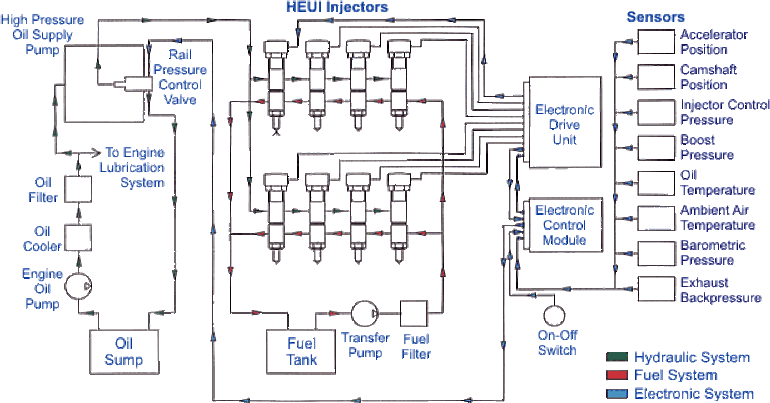HEUI stands for Hydraulic Electronic Unit Injector, and it refers to a type of fuel injection system used in some diesel engines. The HEUI system is primarily associated with engines manufactured by Caterpillar and is commonly found in various applications, including trucks (Powerstroke engines build by International), buses, and some industrial equipment.

Here's a basic overview of how an HEUI fuel system works:
Hydraulic System: Unlike traditional fuel injection systems, HEUI uses engine oil to
pressurize and actuate the fuel injectors. A high-pressure oil pump delivers oil to the
injectors at high pressure.
Electronic Control: The injection process is electronically controlled. The engine
control module (ECM) precisely manages the timing and duration of the fuel injection
based on various engine parameters such as speed, load, and temperature.
Unit Injectors: Each cylinder has its own unit injector. The injector contains a plunger
and a solenoid valve. When the solenoid is energized, it opens the injector, allowing
high-pressure oil to act on the plunger, which in turn pressurizes and injects the fuel into
the combustion chamber.
Oil-Fueled Injection: The high-pressure oil not only actuates the injectors but also
serves as the medium to pressurize and inject the fuel into the combustion chamber.
This is a departure from traditional systems where fuel is pressurized separately from
the engine oil.
The HEUI injector’s job is to inject fuel at high pressure when the PCM/ECM commands
it. The PCM does so by sending signals to the IDM (Injector Driving Module) or FICM
(Fuel injection control module). The IDM controls the solenoid by controlling the voltage.
Depending on the voltage, the solenoid releases the force on the poppet valve. Since
the poppet valve is counter-pushed by springs, as the solenoid releases it, it is pushed
up by the springs. This opens a pathway for the pressurized oil to fill in the cavity. This
pressure is decided on engine load rather than engine speed.
The pressurized oil then pushed the intensifier piston. The piston in return pushes the
fuel in the cavity located at the injector’s nozzle. Again the injector nozzle valve is kept
closed using the spring action.
Only when the fuel reaches a preset pressure does it overcome the spring force and
exit the nozzle. Since the nozzle exit is incredibly small, the high-pressure fuel going out
of an even smaller area gets atomized. The atomized fuel enters the combustion
chamber and combustion happens.
The advantages of the HEUI system include precise control over the fuel injection
process, which can contribute to better fuel efficiency, reduced emissions, and improved
engine performance. However, these systems can be complex and may require special
diagnostic tools for troubleshooting.
It's worth noting that HEUI systems are just one type of fuel injection system used in
diesel engines, and there are other systems like Common Rail Injection (found in many
modern diesel engines) and others, each with its own set of advantages and
disadvantages.


